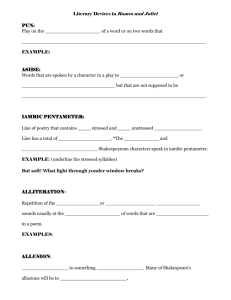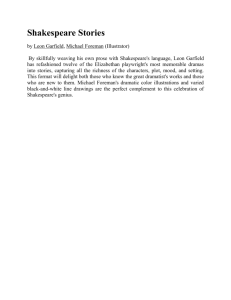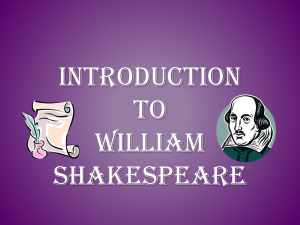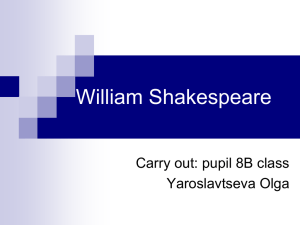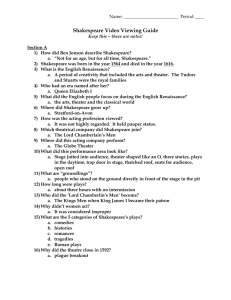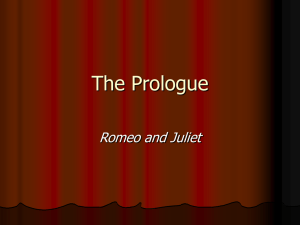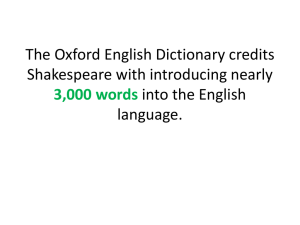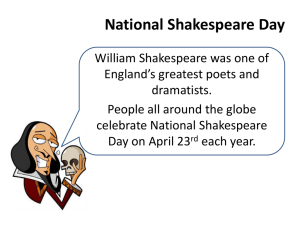Dramatic terms
advertisement
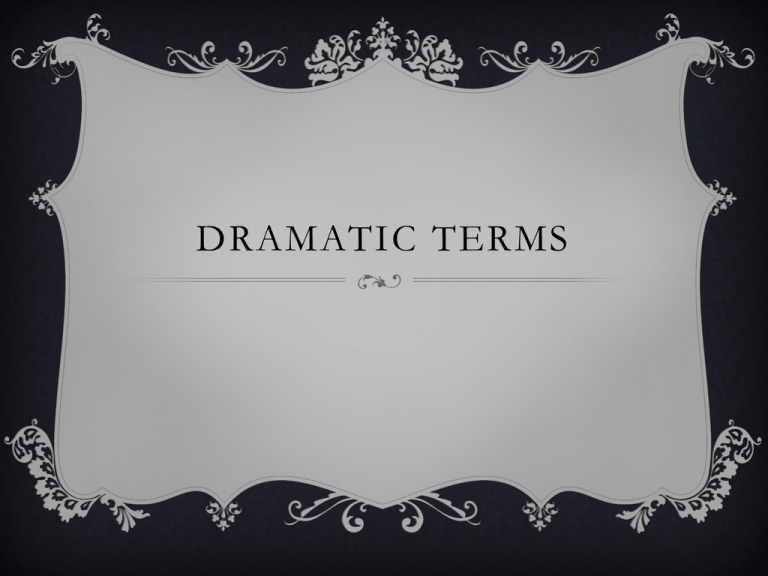
DRAMATIC TERMS A figure of speech that implies or states a comparison between two unlike things which are similar in some way. Unlike another literary device, this device does not use “like” or “as.” Example: “It is the East, and Juliet is the sun!” A brief remark made by a character and intended to be heard by the audience but not by other characters. A type of drama of human conflict which ends in defeat and suffering. Often the main character (dignified, noble) has a tragic flaw (weakness of character, wrong judgment) which leads to his or her destruction. Sometimes the conflict is with forces beyond the control of the character—fate, evil in the world. A humorous scene or speech in a serious drama which is meant to provide relief from emotional intensity and, by contrast, to heighten the seriousness of the story. A figure of speech in which human qualities are attributed to inanimate objects, animas, or ideas. Example: “Jocund day/ Stands tiptoe on the misty mountain tops.” A main division of a drama. Shakespeare’s plays consist of five with each subdivided into scenes. A small unit of a play in which there is no shift of locale or time. A reference to a literary or historical person or event to explain a present situation. From mythology: : “She’ll not be hit/ With Cupid’s arrow. She hath Dian’s wit. . .” A contrast between what is and what appears to be. One type is verbal in which a character says one thing and means another. Another is dramatic in which the audience knows what the characters do not. A form developed in Italy in the thirteenth century. A century later, Petrarch raised it to its greatest perfection and gave it his own name (the Petrarchan ______). Wyatt and Surrey introduced the form to England, but because the rhyme pattern was too confining for English (the Italians allowed no more than five rhymes), it was modified. Because Shakespeare achieved greatest fame with the English ______, his name became attached (the Shakespearian ______). The Petrarchan form consists of two divisions: eight lines with a rhyme scheme of abba abba (called an octave) and six lines with varying patterns of cdc cdc or cde cde (called a sestet). The Shakespearian form consist of four divisions: three sets of four lines each (called quatrains) and a pair of rhyming lines (called a couplet) with a usual rhyme scheme of abab cdcd efef gg. Meter for both sonnet forms is usually iambic pentameter. Not only was it common in Shakespeare’s time to write plays in poetry, but the strong rhythm of the verse also made it easier for the actors to memorize their lines. Shakespeare used a verse form called blank verse. It is unrhymed iambic pentameter which consists of five metrical feet with each foot having an unstressed, stressed pattern. Iamb: two syllables, unstressed followed by stressed (example: afraid) Pentameter: Ten syllables or beats in each line. Example: “If I profane with my unworthiest hand,/ This holy shrine, the gentle sin is this” *Note: Sometimes Shakespeare used prose where it suited his purpose. Pay attention as you read Romeo and Juliet to Shakespeare’s subtle changes in language and think about what effect these language choices have on our understanding of the play. A contrast of two contradictory terms for the sake of emphasis. Example: “A damned saint, an honourable villain.” A speech given by a character alone on the stage. The purpose of this is to let the audience know what the character is thinking and feeling. The repetition of the same initial sound in two or more consecutive or closely associated words. Example: “Now old desire doth in his deathbed lie.” A figure of speech that states a comparison between two essentially unlike things which are similar in one aspect. They are introduced by “like” or “as.” Example: “She hangs upon the cheek of night/ Like a rich jewel in an Ethiop’s ear.” A minor character used to contrast a main character A long speech by an actor directed to one or more actors The humorous use of a word or phrase in which its different meanings are emphasized. This appears frequently in Shakespeare’s plays and in comedy today. For example, when the generally humorous character Mercutio receives a fatal wound in a duel, he says the following: “Ask for me tomorrow, and you shall find me a grave man.” A philosophy of love and a code of love-making which flourished in chivalric times, first in France and later in other countries, especially in England. According to the system, falling in love is accompanied by great emotional disturbances; the love is bewildered, helpless, tortured by mental and physical pain, and exhibits certain “symptoms,” such as pallor, trembling, loss of appetite, sleeplessness, sighing, weeping, etc. He agonizes over his condition and indulges in endless self-questioning and reflections on the nature of love and his own wretched state. His condition improves when he is accepted, and he is inspired to great deeds. He and his lady pledge each other to secrecy, and they must remain faithful in spite of all obstacles. According to the strictest code, true love was held to be impossible in the married state. (Maybe because many marriages were arranged.) The kind of conceit used by the Italian poet Petrarch in his love sonnets and widely imitated by Renaissance English sonneteers. It rests upon elaborate and exaggerated comparisons expressing in extravagant terms the beauty, cruelty, and charm of the beloved and the suffering, sorrow, and despair of the forlorn lover. Oxymoron is common.
